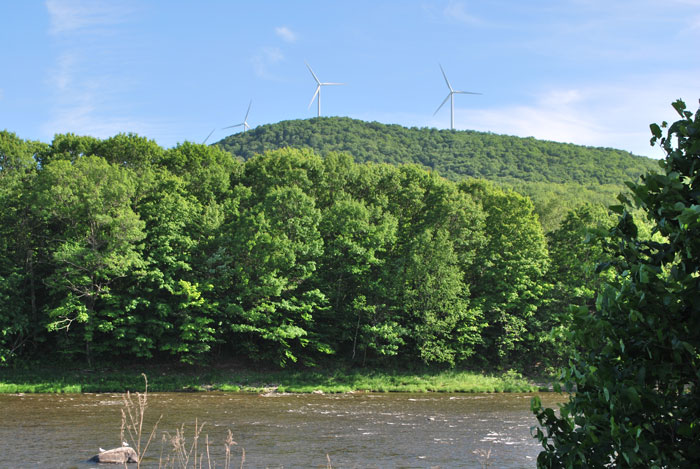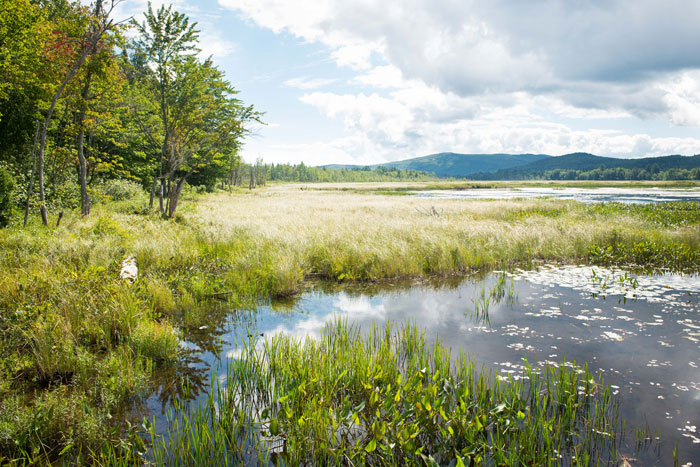| — Listen to Your Mother — Vermont Faces Challenges Funding Watershed Cleanup, Meeting Energy Goals |
||||
| by K.C. Whiteley | ||||
|
Vermont has struggled for years to deal with increasing amounts of phosphorus pollution levels in Lake Champlain and other watersheds. Ordered by the EPA to meet reduced limits, the Scott administration supported a proposal by State Treasurer Beth Pearce to come up with two years of bridge funding (about $25 million for each year) to begin to address this chronic issue that affects water quality, not just in Lake Champlain but in the Lake Memphremagog and the Connecticut River watersheds as well. Together, these three watersheds cover about 94 percent of the state. Because of Gov. Scott’s no new taxes or fees pledge, Pearce’s long-term plan, which called for a per parcel fee, became a short-term fix, shifting funds from the capital bill, bonds and extending the property transfer tax surcharge. As Robb Kidd, manager of the Conservation Program for the Vermont chapter of the Sierra Club, notes, this short-term solution ultimately does not address the problem: “the hard work of establishing a long-term funding was not yet established, for the Governor opposed all plans to establish any new taxes or fees.” |
|||
Cleanup is expected to take 20 years. According to Pearce’s estimates, Vermont will need to find about $35 million a year for the next 20 years to meet our phosphorus reduction goals. Current legislation and proposed funding leaves unanswered the question of how to fund lake cleanup in the long term. James Ehlers, executive director of Lake Champlain International, offers his belief that clean water is not a priority for Scott: “Where do you set priorities? It’s not in these press conferences, it’s in the budget. Clean water is not a priority.” Adding to this lack of commitment, Kidd noted a deal, late in the legislative session, with the governor that stripped “over a $1 million dollars of water funding to help pay for a housing bond.” While it may not seem like a huge amount, the original total of $5 million was flexible funding. Now there’s 20 percent less. Lauren Hierl expressed the frustration shared by a range of environmentalists, legislators, and ordinary Vermonters who “want to understand that funding will be there so that we can actually plan ahead and stay on track to clean up our waters. One big step in that direction would be to put a per parcel fee into effect if lawmakers can’t come up with a better solution.”
Gov. Scott said he supports Vermont’s comprehensive energy goals (90 percent renewables by 2050) but has not yet put forth a plan to achieve it. His opposition to wind as a renewable source in the clean energy portfolio adds to that challenge. Former Vermont Health commissioner Dr. Harry Chen said he knew of no such connection: “To date, no scientific research has been able to demonstrate a direct cause‐and‐effect link between living near wind turbines, the noise they emit, and physiological health effects.” Nonetheless, the PSB established a limit of 39 decibels at night and 42 during the day. According to documents submitted with the rules, the turbines would be less than “sound levels in a library, or those produced by a stream or a refrigerator.” Sarah Wolfe, a clean energy advocate at the Vermont Public Interest Research Group (VPIRG) said, in a May 18, 2017, VTDigger, article “This is a clear ban on wind. The board chose to ignore the evidence and take this important resource off the table.” The number of sites in Vermont that are appropriate for wind installations are scarce. Like others working to promote renewable energy, Wolfe feels strongly that the PSB put the complaints of a few ahead of Vermont’s commitment to reduce its fossil fuel dependence. She fears Vermont will not meet its 2050 renewable goal without wind power. Deb Markowitz led the Agency of Natural Resources (ANR) during the six-year Shumlin administration, a time of progress on energy policies to combat climate change; promotion of clean water, energy efficiency, and universal recycling; and attention to forest fragmentation and Lake Champlain cleanup. She has adopted a perspective of watchful concern as the Trump administration turns its back on the reality of climate change. But even though the environment may not be a priority for the Scott administration, Markowitz does not anticipate rollbacks to established policies. She remains positive about what we can accomplish in Vermont because of broad public support for a clean energy future. Vermonters know “how important it is to preserve and protect our environment.” Markowitz expressed a hopeful and nuanced outlook on wind, both acknowledging the limited opportunities for new projects and the evolving technology. She forecasts opportunities for “smaller footprints and more efficiency. We have great mapping now. It [wind] will come back once we get it right.”
Markowitz bases her optimism about the future of renewables in data demonstrating job growth. Costs of wind and solar are dropping, more and more workers are employed in the green economy, and renewables produce more energy per MWH and cost less than fossil fuel extraction like coal. “States and local leadership matters. More than 30 states, including Vermont, have adopted plans with aggressive goals for investing in renewable energy, and for reducing climate pollution. These states are red and blue, and include a majority of the U.S. population and economic productivity. If states implement their plans then the country will be on track to meet our global commitment to reduce greenhouse gas pollution by 40 percent below 1990 levels by 2030.” She is convinced that, despite Trump’s deep cuts to established climate programs, states can lead the way and continue to make progress. The ANR’s newly appointed secretary Julie Moore comes to her post with a deep background and understanding of water quality concerns and watershed management programs, including previous work with the ANR to address the phosphorus pollution in Lake Champlain. She views the 2017 legislative session largely as one of implementing previous years’ major policy initiatives and making some necessary adjustments.
Both Markowitz and Moore are concerned about funding cuts promised by the Trump administration. With about a third of ANR’s budget coming from the federal government, Moore knows that cuts “will touch all aspects of our work, core environmental programs, clean air and water resources, and conservation. We would see a significant decline for the Department Fish and Wildlife and our county foresters.” Markowitz is especially concerned about Trump’s defunding of science. States and a host of agencies and organizations, not to mention citizens, depend on the EPA (Environmental Protection Agency) and NOAA (National Oceanic and Atmospheric Administration) for up-to-date scientific information. These tools and resources are becoming inaccessible, and it appears much critical data may no longer be collected. Another challenge is that federal regulations and requirements are not being trimmed, just the funding. As a member of the Environmental Council of States, Moore represents Vermont with her national counterparts. All the states are looking at similar funding cuts, “so there’s some comfort knowing there’s strength in numbers addressing this.” Moore encourages Vermonters to get personally involved. There are lots of opportunities from river cleanups to town energy committees and local conservation projects, she said. She encourages citizens to “find something that aligns with your interests.” Markowitz emphasizes how important it is to speak up, to understand how government operates, the balance of power and the concept of “cooperative federalism,” which allows states to implement federal environmental laws. “Don’t underestimate Vermont leadership on these issues,” she said. This makes it all the more important for us to elect leadership who will commit Vermont to its renewable energy goals.
|
||||
|
K.C. Whiteley lives in Montpelier and is a member of Central Vermont Climate Action and the 350VT board. During the winter she lives in New Orleans and works with 350LA.
|
|||



_WEB.jpg)